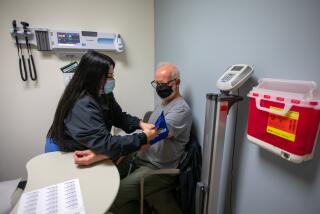Prescribing Penmanship
The question facing Dr. Paul Hackmeyer was this: How could he convince his hospital’s doctors that their penmanship ranked right up there with hieroglyphics? Doctors’ handwriting is, of course, one of the oldest jokes around. But for Hackmeyer, the Cedars-Sinai Medical Center chief of staff, it was becoming a serious problem.
Doctors complained they couldn’t read other doctors’ notations. Nurses and pharmacists were fed up trying to decipher whether patients were to be given antibiotics or antidepressants. So Hackmeyer hit on a plan: Send his staff back to elementary school. Well, sort of.
He found a couple of teachers in Oregon who specialized in teaching handwriting. His next move was not so simple. How would he make these highly educated, time-pressed professionals realize their penmanship was a close relative of chicken scratch?
To that end, Hackmeyer devised a contest in which he offered a free lunch at the Four Seasons for anyone who could decipher a collection of medical instructions penned by the hospital’s most illegible doctors. Point made. No one could read them, not even Hackmeyer. (The lunch was raffled off.)
To take his case a step further, Hackmeyer dubbed one egregious offender on staff the poster boy of his cause, plastering his mug and so-called penmanship around the hospital. The scapegoat was Dr. Marshal Fichman, an internal medicine specialist. “I’m not surprised, because I have the worst handwriting in the hospital,” said Fichman, who had his straight A’s in third grade ruined by a B in penmanship.
“It’s been downhill ever since,” he joked.
Having gotten the doctors’ attention, it was time to train them. Enter Barbara Getty and Inga Dubay, two former Oregon elementary teachers who arrived with their lined handwriting booklets and a bit of angst about teaching to a tough crowd.
To their surprise, they discovered their new students were not too proud to relearn elementary lettering. The doctors’ scrawl actually is about average, but the stakes are higher, said Getty, who with Dubay recently published a book about their loopless handwriting technique.
“For them it really counts,” she said.
The numbers bear that out. In a world in which 98,000 people die each year in the U.S. because of medical error, according to a study by the Institute of Medicine, a legible medical chart can sometimes mean the difference between life and death. Doctors don’t deny that some of those errors may stem from misread prescriptions or other medical orders.
Since their first visit to Cedars-Sinai last year, Getty and Dubay have found a lot of hospitals eager to train doctors in proper penmanship. They’ve traveled to 17 hospitals across the country demonstrating alternative ways to hold a pen and write legible letters.
For foreign-born doctors such as Joseph Varughese, an internal medicine physician at Kaiser Permanente, the class is their first formal introduction to penmanship. Varughese, who is from southern India, said he learned to form letters by pushing rice grains on a slate in school. Since taking the class at Kaiser, he has increased the size of his letters, slowed down his writing, gotten rid of loops, and subsequently has received fewer clarification calls from pharmacies.
“After 40 years of doing it my own style, to go back to the basics was very exciting,” said Varughese, 50, from his office at the Panorama City Hospital. “I would recommend it to anyone because no one else will teach you like the kindergarten teachers.”
Not all pharmacists believe the classes will help but agree something should be done. Arian Moini at Westside Vicente Pharmacy in Brentwood said his pharmacy typically processes 200 or more orders a day and having to call a doctor to verify what he or she’s prescribing “just slows down the whole process.”
Moini said he refuses to fill a prescription unless he is “100% sure” and if in doubt wants “to hear it from the horse’s mouth.” He points out, for example, that it may be hard to interpret whether a doctor is prescribing prilosec, used to treat ulcers, or Prozac, an anti-depressant, both of which come in 20 milligram tablets. “Believe me, there have been many times when pharmacists gave one and not the other.”
He tells some worst-case doctors to have their nurses write out the prescriptions for the doctor to sign. “Most nurses are women and they have better penmanship.” For that matter, he observes, “We rarely get bad handwriting from a female doctor.”
Emergency room doctors drive him crazy, often prescribing multiple medications and writing out prescriptions in a rush. Tracking them down for clarification can be time-consuming, since they may not have an office and may work the same emergency room only certain days of the week.
*
In the emergency department at St. John’s Medical Center in Santa Monica, doctors are using SuperDoc, a hand-held computer, to print out prescriptions for patients being discharged. The computer can give instructions on dosage, side effects and contraindications in fifth-grade-level English, high school English or Spanish. The printout is signed by the attending physician.
“I think there’s going to be a lot more electronic prescriptions in the future, without question,” said Dr. Michael Weitz, associate director of the emergency department. He foresees a time when it will be standard practice for pharmacies to receive computer-generated prescriptions sent by fax. A number of hospitals are examining ways to eliminate their reliance on handwriting altogether. Many in California, complying with a recent state Senate bill mandating a reduction in medical errors, are evolving toward paperless records systems.
Cedars is developing a computerized system that allows doctors to order patient medications, tests and treatments without ever applying pen to paper. Dubbed “the patient care expert,” the system is slated to be running by December. It will not only eliminate ambiguous orders but will also automatically cross-check medications with the patient’s history for any possible adverse drug combinations. Doctors will even be able to prescribe medicine from their home computers.
To get new doctors up to speed at UCLA’s medical center, residents are being trained to rely on the computer. Next month, all third-year UCLA medical students will carry hand-held devices during their rounds. The mini-computers will allow students, among other things, to check drug side effects and recommended doses at a patient’s bedside. At shift changes, patient information--now written on 3-by-5 cards--will be beamed to the incoming resident’s hand-held device.
*
The Cedars pediatrics unit has already been testing the effectiveness of the devices in its resident training program. The transition at Cedars hasn’t been without glitches, though, with complaints about short battery life and the device’s bulkiness and cramped keyboard. Many of the expensive computers have been misplaced. And some doctors say the devices work better in some instances than others.
“It’s useful for people who come in a lot and stay for a long time so you don’t have to ask the mother for the 10th time that month what meds the patient is on,” said Paula Kuhlman, 29, a harried first-year resident in Cedars’ pediatric ward. “But one night I had 17 admissions and all that entering takes time. For patients who come in once for something minor, it just wasn’t useful.”
With the computer not yet the universal panacea for bad handwriting, poster boy Fichman’s office staff continues to get calls from confused pharmacy workers. Betty Francisco, who has worked for Fichman for 14 years, still has trouble deciphering his handwriting. So does Dr. Daniel Fink, Cedars’ medical director of case management.
“Sometimes,” said Fink, “he can’t even read his own handwriting.”
*
Times staff writer Beverly Beyette contributed to this report.
More to Read
Sign up for Essential California
The most important California stories and recommendations in your inbox every morning.
You may occasionally receive promotional content from the Los Angeles Times.










